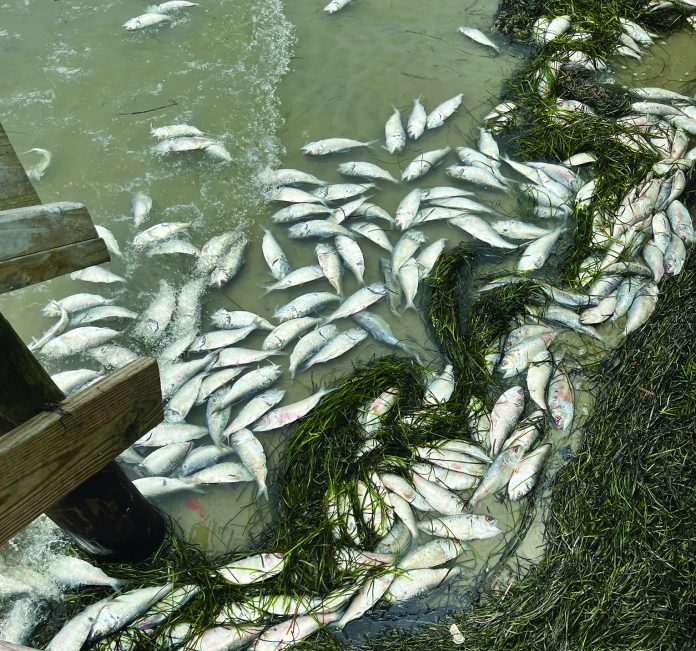BY STEFANIE JACKSON, Eastern Shore Post—
A group of commercial and recreational fishermen is suing the Virginia Marine Resources Commission for not protecting the Chesapeake Bay’s population of menhaden — the herring-like fish that is a food source for sport fish such as striped bass — from further depletion.
The lawsuit filed May 10 alleges that on April 13, VMRC adopted a regulation that, instead of reducing the amount of menhaden caught in Virginia, could actually increase the annual catch by 21,000 metric tons.
The plaintiff is the Southern Maryland Recreational Fishing Organization, a 501(c)(4) nonprofit whose members fish in Maryland and Virginia in and near the Chesapeake Bay.
Phil Zalesak, the organization’s president, stated that over the last decade, the group has noticed a decline in populations of menhaden and the fish including striped bass that feed on menhaden.
The menhaden not only are food for larger fish and birds like ospreys, they are filter feeders that help clean the Chesapeake Bay.
They prefer to eat algae, which can overgrow, forming blooms that block sunlight from marine plants. The death and decay of these algal blooms also deprive marine life of oxygen.
According to the lawsuit, the menhaden population decline caused “damage to Virginia waters” that influenced a decline in organization membership, revenue, and the number of programs the organization can support.
Nearly 1 million recreational fishermen in Virginia contribute $1.3 billion in economic output and support almost 10,000 jobs, Zalesak testified.
Managing fishery
VMRC has been tasked with managing the state’s Atlantic menhaden fishery, preventing overfishing, and practicing conservation based on the “best scientific, economic, biological and sociological information available,” the lawsuit continued.
Every year, the Atlantic Interstate Commission sets the total allowable catch for menhaden for all participating states on the East Coast.
Virginia is allowed to catch about 175,000 metric tons of menhaden per year, or 75% of the total menhaden harvest for the East Coast.
New Jersey has the next highest allowance at just 11% of the total annual menhaden harvest.
Since 2017, the Atlantic Interstate Commission has capped the amount of menhaden that can be caught in the Chesapeake Bay to 51,000 metric tons.
Virginia may set its catch limits lower but cannot exceed those set by the Atlantic Interstate Commission, which increased in 2022.
‘Rubber-stamped’ limit
Omega Protein, a Canadian company, operates the East Coast’s last remaining menhaden reduction fishery, which is in the Chesapeake Bay.
The reduction fishery is so named because the menhaden are reduced to make fish meal, oil, and other supplements.
VMRC granted Omega Protein, called the “Industrial Harvester” in the lawsuit, 90% of Virginia’s annual allowable catch of menhaden, about 158,000 metric tons, which is 21,000 metric tons more than it was permitted to catch last year.
The lawsuit notes that since only 51,000 metric tons of menhaden can be taken from the bay, the remaining 107,000 metric tons of menhaden must be caught elsewhere in Virginia waters.
However, Omega Protein harvests the rest of the menhaden in and near the mouth of the Chesapeake Bay, further depleting the menhaden in the bay and preventing other menhaden from entering the bay and replenishing the menhaden population, the plaintiff contends.
The lawsuit argues that VMRC acted unlawfully when it “rubber-stamped” the Atlantic Interstate Commission’s new menhaden catch limit without considering available scientific data or applying conservation and management practices as required by Virginia statute.
The lawsuit also argues that VMRC acted unlawfully by adopting the regulation in April; the prescribed period to adopt menhaden management regulations is from Oct. 1 to Dec. 31.
The plaintiff is asking the court for relief including: striking the adopted regulation, requiring VMRC to rewrite the regulation in a manner that protects Virginia waters and the Chesapeake Bay, setting a timeline for VMRC to complete its analysis and enact the new regulation, and awarding the petitioner’s costs and attorneys’ fees.



